
Rudolf II was Holy Roman Emperor (1576–1612), King of Hungary and Croatia, King of Bohemia (1575–1608/1611) and Archduke of Austria (1576–1608). He was a member of the House of Habsburg.

The Kunsthistorisches Museum is an art museum in Vienna, Austria. Housed in its festive palatial building on the Vienna Ring Road, it is crowned with an octagonal dome. The term Kunsthistorisches Museum applies to both the institution and the main building. It is the largest art museum in the country and one of the most important museums worldwide.

The Albertina is a museum in the Innere Stadt of Vienna, Austria. It houses one of the largest and most important print rooms in the world with approximately 65,000 drawings and approximately 1 million old master prints, as well as more modern graphic works, photographs and architectural drawings. Apart from the graphics collection the museum has recently acquired on permanent loan two significant collections of Impressionist and early 20th-century art, some of which will be on permanent display. The museum also houses temporary exhibitions. The museum had 360,073 visitors in 2020, down 64 percent from 2019 due to the COVID-19 pandemic, but still ranked 55th in the List of most-visited art museums in the world.

The Vienna Ring Road is a 5.3 km circular grand boulevard that serves as a ring road around the historic Innere Stadt district of Vienna, Austria. The road is located on sites where medieval city fortifications once stood, including high walls and the broad open field ramparts (glacis), criss-crossed by paths that lay before them.
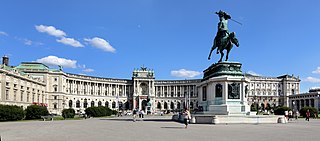
The Hofburg is the former principal imperial palace of the Habsburg dynasty. Located in the centre of Vienna, it was built in the 13th century and expanded several times afterwards. It also served as the imperial winter residence, as Schönbrunn Palace was the summer residence. Since 1946, it is the official residence and workplace of the president of Austria.

Johann Lukas von Hildebrandt was an Austrian baroque architect and military engineer who designed stately buildings and churches and whose work had a profound influence on the architecture of the Habsburg Empire in the eighteenth century. After studying in Rome under Carlo Fontana, he constructed fortresses for Prince Eugene of Savoy during his Italian campaigns, becoming his favorite architect. In 1700 he became court engineer in Vienna, and in 1711 was named head of the court department of building. He became court architect in 1723. His designs for palaces, estates, gardens, churches, chapels, and villas were widely imitated, and his architectural principles spread throughout central and southeast Europe. Among his more important works are Palais Schwarzenberg, St. Peter's Church, and Belvedere in Vienna, Savoy Castle in Ráckeve, Schönborn Palace in Göllersdorf, and Schloss Hof.

Margaret Theresa of Spain was, by marriage to Leopold I, Holy Roman Empress, German Queen, Archduchess of Austria and Queen of Hungary and Bohemia. She was the daughter of King Philip IV of Spain and the elder full-sister of Charles II, the last of the Spanish Habsburgs. She is the central figure in the famous Las Meninas by Diego Velázquez, and the subject of many of his later paintings.
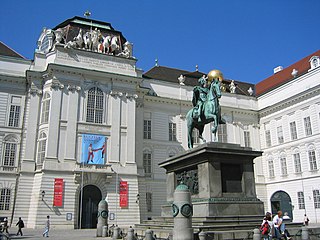
Josefsplatz is a public square located at the Hofburg Palace in Vienna, Austria. Named after Emperor Joseph II, Josefsplatz is considered one of the finest courtyards in Vienna.
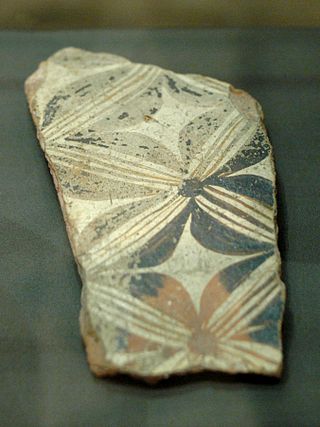
Corpus Vasorum Antiquorum is an international research project for documentation of ancient ceramics. Its original ideal target content: any ceramic from any ancient location during any archaeological period, proved impossible of realization and was soon restricted to specific times and periods. As the project expanded from an original six nations: England, Belgium, Denmark, France, the Netherlands, and Italy, to include the current 28, the topic specializations of each country were left up to the commission for that country. The French commission, serves in an advisory position.

The term "Hofburg fire" refers to any of several major fires that burned in the Hofburg of Vienna, Austria. The Hofburg area has been the documented seat of government since 1279. Each fire destroyed different parts of the Hofburg, in different centuries, and can be termed the "Hofburg fire" due to the historical impact during a particular century:

Joseph Emanuel Fischer von Erlach, also Fischer von Erlach the younger was an Austrian architect of the Baroque, Rococo, and Baroque-Neoclassical.

Ambras Castle is a Renaissance castle and palace located in the hills above Innsbruck, Austria. Ambras Castle is 632 metres (2,073 ft) above sea level. Considered one of the most popular tourist attractions of the Tyrol, Ambras Castle was built in the 16th century on the spot of an earlier 10th-century castle, which became the seat of power for the Counts of Andechs. The cultural and historical importance of the castle is closely connected with Archduke Ferdinand II (1529–1595) and served as his family's residence from 1567 to 1595. Ferdinand was one of history's most prominent collectors of art. The princely sovereign of Tyrol, son of Emperor Ferdinand I, ordered that the medieval fortress at Ambras be turned into a Renaissance castle as a gift for his wife Philippine Welser. The cultured humanist from the House of Habsburg accommodated his world-famous collections in a museum: the collections, still in the Lower Castle built specifically for that museum's purpose, make Castle Ambras Innsbruck one of the oldest museums in the world.

The Weltmuseum Wien in Vienna is the largest anthropological museum in Austria, established in 1876. It is housed in a wing of the Hofburg Imperial Palace and holds a collection of more than 400,000 ethnographical and archaeological objects from Asia, Africa, Oceania, and America.

The Imperial Carriage Museum is a museum of carriages and vehicles used by the imperial household of the Holy Roman Empire, the Austrian Empire and Austria-Hungary. It is housed in the grounds of the Schloss Schönbrunn in the Hietzing district of Vienna and is a department of the Kunsthistorisches Museum.

The Chamber of Art and Wonders is a cabinet of curiosities created in the 16th century by Ferdinand II, Archduke of Austria and located in Innsbruck, Austria. Ferdinand II was the sovereign ruler of the County of Tyrol and Further Austria, and a prominent collector of art. He built this museum specifically to showcase his collections.

The Vienna Hofburg Orchestra is an Austrian classical orchestra based in Vienna.
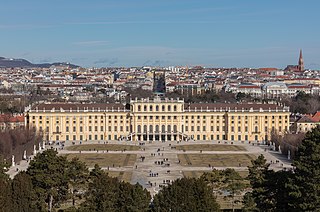
The tourist attractions of Vienna concentrate in three distinct areas. The largest cluster, centred on Schönbrunn Palace, attracted around five million visitors in 2009, down from six million in 2008. Museums and exhibitions of Hofburg Palace accounted for nearly two million visitors in 2008, with a significant decline in 2009. The third, and the newest, cluster of modern art museums in Museumsquartier attracted less than one million visitors. Nearby duo of Kunsthistorisches and Naturhistorisches museums, located halfway between Museumsquartier and Hofburg, also reported around one million visitors. The Landstraße district, which lies south-east of the old city, is home to art exhibitions at the Belvedere Palace and the KunstHausWien.
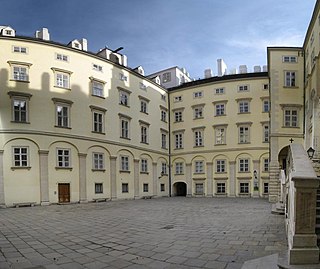
The Governor of Hofburg Palace is in charge of the Hofburg palace in Vienna. The office is under auspices of the Burghauptmannschaft.
Bernhard A. Macek is an Austrian historian and author.

Nikos Floros is a Greek sculptor. He is known for creating sculptural art by using aluminium cans for soft drinks as raw material. This technique was created and patented by Nikos Floros in New York in 2003.



















